





"There are no hothouse blossoms that can compare in beauty and fragrance with my bouquet of wild flowers." So declared Laura Ingalls Wilder decades after her pioneer childhood. As a little girl, Laura thrilled to the colors and scents of the wildflowers she encountered in the woods and vast prairies of newly settled American territory. As an adult author, she used her memories of the natural world to bring the historic Midwest landscape to life in the "Little House" books.
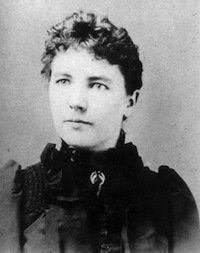 Laura Ingalls was born in 1867 near Pepin, Wisconsin. For most of her childhood, she and her mother and three sisters travelled ever-westward with her restless pioneer father, finally settling in De Smet, South Dakota. In 1894, Laura and her husband Almanzo Wilder bought property in the Missouri Ozarks, where they remained for the rest of their lives. Years later, at the urging of her daughter, Rose Wilder Lane, she began recording memories of life on the prairie. In 1932, Laura published the first book in the Little House series, “Little House in the Big Woods,” recounting her early years in Wisconsin. She continued the story in “Farmer Boy,” ‘Little House on the Prairie,” “On the Banks of Plum Creek,” “By the Shores of Silver Lake,” “The Long Winter,” “Little Town on the Prairie” and “These Happy Golden Years.” Laura Ingalls Wilder died in 1957, just a few days after her 90th birthday.
Laura Ingalls was born in 1867 near Pepin, Wisconsin. For most of her childhood, she and her mother and three sisters travelled ever-westward with her restless pioneer father, finally settling in De Smet, South Dakota. In 1894, Laura and her husband Almanzo Wilder bought property in the Missouri Ozarks, where they remained for the rest of their lives. Years later, at the urging of her daughter, Rose Wilder Lane, she began recording memories of life on the prairie. In 1932, Laura published the first book in the Little House series, “Little House in the Big Woods,” recounting her early years in Wisconsin. She continued the story in “Farmer Boy,” ‘Little House on the Prairie,” “On the Banks of Plum Creek,” “By the Shores of Silver Lake,” “The Long Winter,” “Little Town on the Prairie” and “These Happy Golden Years.” Laura Ingalls Wilder died in 1957, just a few days after her 90th birthday.
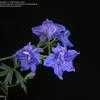
“The wild larkspur was blossoming pink and blue and white, birds balanced on yellow plumes of goldenrod, and butterflies were fluttering. Starry daisies lighted the shadows under the trees...”
Little House on the Prairie
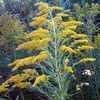
Wild Larkspur (Delphinium carolinianum)
The wild larkspur has finely divided leaves and blue or purple flowers. The flower looks like the spur on a lark’s foot, and it was sometimes called “lark’s heel” or “lark’s claw”. Found in open woods, meadows and on dry grassy slopes in the mountains, the larkspur is most prevalent in the west. Among ranchers, the plant was known as “staggerweed” or “locoweed” because of its toxic effect on cattle. The toxin is a mixture of alkaloids, which is also poisonous to humans. Larkspur is a relative of the delphinium, which is highly valued as a perennial in ornamental gardens.
Goldenrod (Solidago canadensis)
Growing throughout the U.S., the magnificent autumn-blooming goldenrod can reach 5 feet tall and send a taproot as long as 11 feet deep into rich prairie soil. Goldenrod is so ubiquitous that we take it for granted, but it has an important place in the ecology and is a beneficial medical plant. It is one of the most valuable bee plants. The golden-yellow flower clusters which rise in plumes above the plant open from top to bottom, the better to compete with asters and sunflowers for pollinators. Although goldenrod has gotten a bad reputation as a cause of allergic reactions, the real culprit is ragweed, which blooms nearby and at the same time.
Goldenrod has a long history as a pharmeceutical plant. The Chippewa named the goldenrod “sun medicine” and used it for colds, toothache, boils, burns, snakebite and fever. Native Americans and the early settlers used the flowers to make a yellow dye. Solidago gigantea is the state flower of Nebraska. In 1895, it was actually considered as a possibility for the country’s national flower.
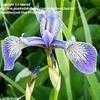
“Along the creek rushes were growing, and blue flags. Every morning the blue flags were new. They stood up dark blue and proud among the green rushes. Each blue flag had three velvet petals that curved down like a lady’s dress over hoops. From its waist three ruffled silky petals stood up and curved together. When Laura looked down inside them, she saw three narrow pale tongues, and each tongue had a strip of golden fur on it.”
On the Banks of Plum Creek
Blue Flag (Iris versicolor)
By the name “blue flag,” Laura was probably referring to either Iris versicolor or Iris virginica, whose violet blue flowers appear in early to midsummer. The plant’s familiar sword-shaped leaves are commonly found in marshes, wet meadows and forested wetlands. The iris root contains iridin, a toxic chemical which can be medicinal in small doses. The Ojibway carried pieces of the root as a charm, believing that the scent could keep snakes away. Both early settlers and Indians used the root as a remedy to relieve pain and swelling from injuries.
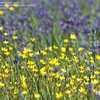
“They liked the long walks together in the wind and sunshine, picking violets and buttercups and eating sheep sorrel. The sheep sorrel’s lovely curled lavender blossoms, the clover-shaped leaves and thin stems had a tangy taste.”
Little Town on the Prairie
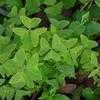
Buttercup (Ranunculus rhomboides)
The bright yellow buttercup is one of the first prairie wildflowers to bloom in the spring, and was surely a welcome sight to the pioneers after a long, cold winter. Although buttercups contain an irritant which can harm a grazing animal’s stomach, poisoning is rare because of the plant’s bad taste. The plant can also cause an allergic reaction when it comes in contact with the skin.
Sorrel (Oxalis violacea)
Wood sorrel (Oxalis violacea) and sheep sorrel (Rumex acetosella) are unrelated, but they are both edible, having a slightly sour lemony taste, and have been linked together. Laura’s description of a lavender flower on a shamrock-shaped leaf resembles the wood sorrel. Growing 6 inches tall from an underground rhizome, the five-petaled flowers bloom from May to August. The plant gets its sour taste from oxalic acid, and in small quantities is pleasant.
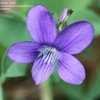
“Summer was before her, with blue skies and great blowing white clouds, the violets blooming in the buffalo wallow and the wild roses spangling the prairie.”
Little Town on the Prairie
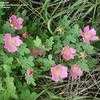
Violet (Viola pedatifida)
Violets can be found growing throughout the United States and include dozens of species with flowers of purple, blue, white or yellow. All have five petals: two at the top, two at the sides, and one striped petal at the bottom. These stripes are like a landing pad for bees, leading them to the heart of the flower. The deep violet-blue prairie violet (Viola pedatifida) has divided leaves similar to the delphinium.
Wild rose (Rosa acicularis)
The 4-foot-tall wild rose of the prairie, displaying deep pink flowers and bright red fruit, no doubt reminded the pioneers of the gardens they had left behind. The Native Americans ate the fruits of the rose fresh or roasted, and made rose hips into necklaces to be used in trade. Prairie settlers also ate the rose hips, which are filled with vitamin C. Three rose species are called prairie rose--Rosa arkansana, Rosa woodsii and Rosa acicularis.
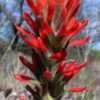
“...she wandered over the field, picking the wild sunflowers and Indian paintbrush.”
The First Four Years

Sunflower (Helianthus)
The most recognizable prairie plant of all, the sunflower is the state flower of Kansas. Its giant yellow flower heads are an impressive sight in late summer and early autumn. The sunflower originally ranged only throughout western North America, although it has now spread to parts of the east. The sunflower represented the sun god in legends of some native American tribes, who used the seeds for flour and carried them as a portable snack.
Indian Paintbrush (Castilleja linariaefolia)
The Indian paintbrush is the state flower of Wyoming. Although the plant’s true flowers are inconspicuous, they are surrounded by brilliant flower-like bracts which resemble a brush dipped in red paint. Some Indian tribes use the flowers as a condiment, a hair wash and an actual paintbrush.
Images:
Prairie Sunflower by Clarence A. Rechenthin, courtesy of USDA NRCS Texas State Office. Knox City, TX
Photograph of Laura Ingalls Wilder in the public domain
Dave's Garden photographs courtesy of Todd_Boland, poppysue, laurief, GardenGuyKin, Floridian, LadyAshleyR, Jeff_Beck, Xenomorf
Sources:
Herbert Hoover Presidential Library and Museum - Laura Ingalls Wilder
Laura Ingalls Wilder, Farm Journalist: Writings From the Ozarks; ed. Stephen W. Hines; University of Missouri Press; 2007
The Little House series, by Laura Ingalls Wilder
Copyright © www.100flowers.win Botanic Garden All Rights Reserved